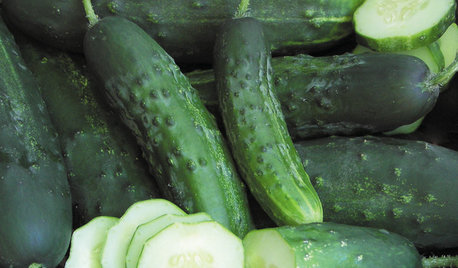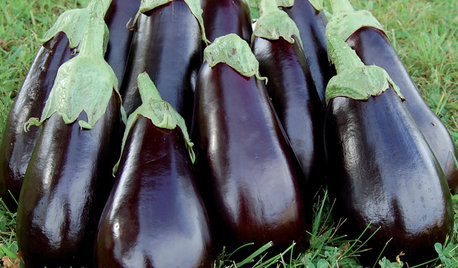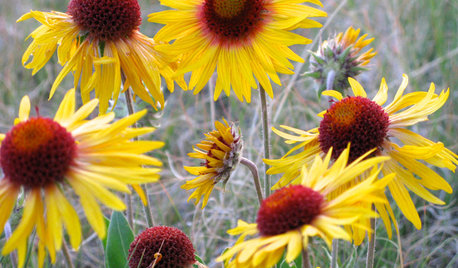Striped Cucumber Beetle
Peter (6b SE NY)
8 years ago
Featured Answer
Sort by:Oldest
Comments (26)
wayne_5 zone 6a Central Indiana
8 years agoPeter (6b SE NY)
8 years agoRelated Discussions
striped cucumber beetles - they're everywhere!
Comments (19)"Let me just say I don't get them in my garden, but a place not too far away where I volunteer has them by the millions. I let the dill and arugula go, and several plants in the yard attract beneficials and they seem to keep most critters at bay. Dan" I do have lots of dill flowering - great for making pickles too :) I did have cilantro flowering - but I harvested the coriander seeds for spices and replanting. There are some kale and radishes flower....also a lot of oregano flowering... Interestingly - I just peaked into the yard to see what was flowering - and there was a group of sparrow (or look like sparrow birds) sitting on various supports near the cukes. Every so often, one would dart into the cuke vines.....they were hunting something.... research says sparrows are primarily seeds and occasional small insects, so hopefully the are feasting or at least snacking on these CB. In the 5 days since the OP - I haven't noticed much of a change in the cukes, still harvesting daily, I'm thankful to say....volume is down, but then temps are too so I think that is expected....See MoreStriped cucumber beetle decimating my melon plants
Comments (7)The steps in Integrated Pest Management are, 1. Identify the problem, (which you have done) 2. Determine if a control is necessary. (also done) 3. Determine the least toxic, least environmentally harmful, means of control. 4. Apply that means of control. 5. Review. So you have a problem, the Stripped Cucumber Beetle, in fairly large numbers and since they are on the plants Floating Row covers would not help at this time. Next would be are there predators present in large enough numebrs to control the buggers and if not what would be next? Would Insecticidal Soap work? If that did not then maybe Neem Oil products. If that did not work then maybe a pyrethrin product. And for next year plan on placing the Floating Row Covers when the melons are planted as well as making sure you have a good, healthy soil to grow them in....See MoreStriped Cucumber Beetle Control
Comments (2)Yellow ladybugs are often mistaken for spotted cucumber beetles. They are actually easy to distinguish: the ladybug has a perfectly round body and the cucumber beetle is more oval and square. The cucumber beetle is a true insect, having a head, a thorax and an abdomen (this latter being the spotted part). The ladybug is not a true bug and it doesn't have these three bodyparts: it only has one lump of a body and its head is integrated in it. Finally, the cucumber beetle has quite prominent antennae while the ladybug's antennae are so small you wouldn't even notice. If it looks just like a red ladybug except for the colour, it most likely is a yellow ladybug and not a cucumber beetle. Compare: Spotted cucumber beetle: http://www4.samford.edu/schools/artsci/biology/invert-03f/pages/122.htm Ladybug (sorry, I couldn't find a yellow one, but it is exactly the same except for the colour, and maybe the number of spots as ladybugs are quite varied): http://www.statesymbolsusa.org/IMAGES/Tennessee/ladybug-in-tennessee.jpg Don't kill your friend and ally the ladybug! It helps get rid of the bad guys (it sustains itself on aphids) even when it is yellow....See MoreStriped Cucumber Beetle Alert
Comments (1)Thanks for the info I think I have these pesky insects hanging around my garden as well. Good luck!...See Morecatherinet
8 years agoPeter (6b SE NY)
8 years agorhizo_1 (North AL) zone 7
8 years agolast modified: 8 years agotcstoehr
8 years agoUser
8 years agoPeter (6b SE NY)
8 years agorhizo_1 (North AL) zone 7
8 years agoPeter (6b SE NY)
8 years agolast modified: 8 years agoeviy
8 years agowayne_5 zone 6a Central Indiana
8 years agoJoe B
8 years agoPeter (6b SE NY)
8 years agorhizo_1 (North AL) zone 7
8 years agoPeter (6b SE NY)
8 years agovgkg Z-7 Va
8 years agodigdirt2
8 years agoPeter (6b SE NY)
8 years agolast modified: 8 years agodigdirt2
8 years agoPeter (6b SE NY)
8 years agolast modified: 8 years agoPeter (6b SE NY)
8 years agogalinas
8 years agogumby_ct
8 years agolast modified: 8 years agoPeter (6b SE NY)
8 years agolast modified: 8 years ago
Related Stories

SUMMER FRUITS AND VEGETABLESSummer Crops: How to Grow Cucumbers
Pick a peck for pickles or opt for fewer and raw — no matter how you slice them, cucumbers are great for summer gardens small to large
Full Story
EDIBLE GARDENSGarden BFFs? Why Your Vegetables Are Begging for Companion Plants
Foster friendships among plants for protection from pests, pollination support and color camaraderie
Full Story
GARDENING GUIDES6 Plants That Beat Butterfly Bush for the Wildlife Draw
It's invasive, a nonnative and a poor insect magnet. Check out these better alternatives to butterfly bush in the garden
Full Story
SUMMER FRUITS AND VEGETABLESHow to Grow Eggplant at Home
Plant glossy purple eggplant as much for its beauty in the garden as its flavor on the plate
Full Story0

EDIBLE GARDENSSummer Crops: How to Grow Tomatoes
Plant tomato seedlings in spring for one of the best tastes of summer, fresh from your backyard
Full Story
FLOWERS AND PLANTSBlanketflower’s Yellow Blooms Brighten Up Summer and Fall Gardens
Gaillardia aristata welcomes wildlife, shrugs off drought and poor soils, and can help restore grasslands
Full Story
FARM YOUR YARDCool-Season Vegetables: How to Grow Beets
Give canned versions of this fall and spring garden favorite the heave-ho and discover its true flavor and colors
Full Story
COOL-SEASON CROPSCool-Season Vegetables: How to Grow Radishes
Fast growing and bright, these easy-care veggies are great for kids and bring plentiful color to a fall or spring garden
Full Story
EDIBLE GARDENSSummer Crops: How to Grow Squash
Almost foolproof and with cheerful flowers, squash comes in a wide range of varieties to plant in spring
Full Story
GARDENING AND LANDSCAPINGBid Bad Garden Bugs Goodbye and Usher In the Good
Give ants their marching orders and send mosquitoes moseying, while creating a garden that draws pollinators and helpful eaters
Full Story



Peter (6b SE NY)Original Author